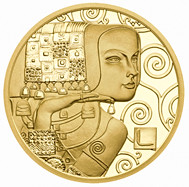
PREV ARTICLE
NEXT ARTICLE
FULL ISSUE
PREV FULL ISSUE
AUSTRIA’S NEW KLIMT GOLD COIN
The February 28, 2013 issue of CoinsWeekly has an article with more information on the new Austrian Klimt coin.
-Editor
On February 27, 2013 the Austrian Mint has issued the second coin in its five gold coin series celebrating Gustav Klimt, a key painter of the art nouveau period whose art is easily recognized and admired around the world. Klimt was born in Austria in 1862 and very early on his artistic gift became evident. He was classically trained, and began his career by painting murals and ceilings in large public buildings. His great love and primary subject, however, was the female form. Klimt tended to work from his home, enjoying a relaxed lifestyle wearing robes and sandals, devoted to his art and life style. His life companion was Emilie Floege whom he met in 1890. Klimt’s love of the female form was not exclusive to his art but to the many relationships he enjoyed. He is known to have fathered 14 children. He died in 1918, at the age of 56, from a heart attack. From about 1885 onward Klimt enjoyed his “Golden Period”, reflecting his critical success and acclaim, as well as his regular use of gold leaf in his paintings. His fame brought many patrons to him and he was able to be selective about the commissions he accepted. Klimt received the Golden Order of Merit from Emperor Francis Josef I in 1888, for the murals he painted in the Palace Theatre. Klimt’s painting entitled “Philosophy” won gold at the Paris Exhibitions of 1900, and “Death and Life” received first prize at the world exhibition in Rome in 1915. Several of Klimt’s paintings have brought some of the highest prices ever paid for art in the world.
The scarf on her head has a very intricate pattern of geometric square-like shapes. Her hand is held in a pose found commonly in Egyptian paintings. Her wrist has a beautifully intricate armband, while more jewels and geometric shapes and swirls can be seen in her clothing. The reverse of the coin was conceived and engraved by mint engraver Herbert Waehner.
To read the complete article, see:
Austria’s new gold coin Klimt and His Women: “Expectation”
(www.coinsweekly.com/en/News/4?&id=1828)
The Numismatic Bibliomania Society is a non-profit organization promoting numismatic literature. See our web site at coinbooks.org. To submit items for publication in The E-Sylum, write to the Editor at this address: whomren@gmail.com To subscribe go to: https://my.binhost.com/lists/listinfo/esylum All Rights Reserved. NBS Home Page Contact the NBS webmaster 
|

